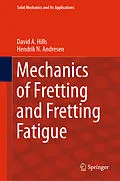This book, which has only one very distant forerunner authored by David A. Hills with David Nowell, represents a very big step that is the quantification of these problems and represents the twenty-five years' worth of work which have gone on at Oxford since the first book on the subject. Fatigue (popularly 'metal fatigue') is the primary failure mode of all machines, engines, transmissions and indeed almost all mechanical devices. The propagation of cracks is well understood and is treated in the subject Fracture Mechanics. By contrast, the nucleation of cracks is very hard to quantify and this remains the case with so-called 'free initiation' and, to a lesser extent, at cracks nucleated from stress raising features. But the third form of nucleation, where cracks start from the edges of rubbing components, that is, at joints, is potentially a very much better-defined environment, and therefore, the problem is amendable to attack by applied mechanics and experiment. The contents are of value both to those embarking on research on the subject and to practitioner in industry.
Autorentext
David Hills read Engineering Science at the University of Oxford, and after a short period in industry did a PhD at what was then Trent Polytechnic, where he was made a lecturer. In 1983 he spent a very educational year at the University of Michigan with Maria Comninou and Jim Barber. In 1984 he secured an appointment in the department in which he had incepted, together with a Fellowship at Lincoln College. He has retained these positions, working mainly on fretting, fretting fatigue and contact problems generally.
Inhalt
1 Some Fundamentals
1.1 Fretting in Practice
1.2 Basics, Equilibrium and 'Coupling'1.3 Friction
1.4 Contact Requirements
1.5 Classes of Contact1.6 Methods of Solution
1.7 Shakedown
1.8 Three Dimensional Aspects
2 Plane Elasticity and Half-Plane Contacts
2.1 Airy Stress Functions and the Half-Plane2.2 Integral Equation Formulation
2.3 Solution
2.3.1 Cauchy Equations of the First Kind2.3.2 Cauchy Equations of the Second Kind
2.3.3 Numerical Solutions
2.4 Mossakovskii-Barber Procedure2.4.1 Normal Loading Problem
2.4.2 Application of a Shear Force
2.4.3 Influence of Bulk Tension2.4.4 Application of a Moment
2.5 Solutions Based on Dislocations
2.6 Summary
3 Williams' Solution
3.1 Introduction
3.2 Antiplane Loading
3.3 General Loading
3.4 Crack Tip and Incomplete Contact Edge Solution
3.5 Bonded Wedges
3.6 Sliding Wedges
4 Half Plane Partial Slip Contact Problems
4.1 Introduction
4.2 The Normal Load Problem for Asymmetrical Contacts4.3 The Sequence of Loading
4.3.1 Sequential Loading (Constant Normal Load)
4.3.2 Proportional Loading
4.3.3 Two-Stage Proportional Loading
4.3.4 Application to a Hertzian Geometry
4.4 The Effect of Differential Bulk Tension
4.4.1 Tangential Load and Moderate Differential Bulk Tension
4.4.2 Bulk Tension Dominated Partial Slip Problems
4.5 Periodic Loading
4.6 More General Loading Scenarios
4.7 General Cyclic Proportional Loading
4.7.1 The Permanent Stick Zone
4.7.2 Mapping between the Normal and Tangential Problems
4.7.3 Example - Tilted Wedge
4.8 Partial Slip Solutions Based on Dislocations
4.8.1 Glide Dislocation Solutions
4.8.2 Example Problem - Cattaneo-Mindlin Problem
4.8.3 Large Bulk Tension Problems
4.9 Antiplane Loading
5 Complete Contacts and their Behaviour
5.1 General Frictional Response - square contacting element
5.2 Finite Slip Zones5.3 Cracks at Contact Edges
5.4 References
6 Representation of Half-plane Contact Edge Behaviour by Asymptotes
6.1 Introduction
6.2 Basic Solution
6.3 Partial Slip: constant normal load
6.4 Partial Slip: varying normal load .
6.5 References
7 Crack Propagation, Nucleation and Nucleation Modelling
7.1 Introduction
7.2 Notch and Critical Distance Methods
7.3 Critical Plane Methods7.4 Short Crack Methods
7.5 Wear and Corrosion
8 Experiments to Measure Fretting Fatigue Strength
8.1 Fundamental and Historic Considerations
8.2 Single Actuator Experimental Apparatus
8.3 Two Actuator Experimental Apparatus8.4 Further Developments
8.5 Concluding Remarks
